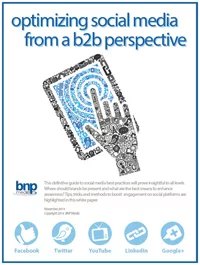Miller Products Offers One-Stop Class "A" Finishing
How can custom coaters maintain a successful niche in an increasingly competitive market? For Miller Products in Grand Rapids, MI, the answer has been to offer a broad array of services to meet virtually any finishing requirement.
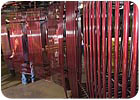
Custom coaters used to be able to focus on one area of expertise - be it powder, electrocoat, wet spray or another technology - to create a successful niche for themselves. Increasingly, however, many finish coaters are finding that they must take on a broad array of services to remain competitive. Miller Products of Grand Rapids, MI, is one such company that has established itself as an industry leader by offering a full complement of electrocoat, powder and wet spray. Jeff Young, the director of quality and administration, sums it up well, “We offer a one-stop, single-source finishing facility.”
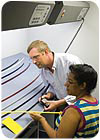
Young says that the employees have been trained in Class “A” inspection, and that the criteria for Class “A” parts have become increasingly rigorous. “A part that 10 years ago would have been considered a Class ‘B’ finish must now be treated as a Class ‘A’ finish. This has helped us grow into new markets because of the evolving market need to provide higher quality,” he says. Such growth is no stretch for an operation accustomed to providing Class “A” products.
The automotive influence has extended into Miller’s process control. Years ago, achieving an ISO 9000 or TS 16949 quality rating was all that was needed to satisfy an automotive customer. While these standards require an operation to keep a process in control - that is, be able to demonstrate repeatability of manufacturing activities - they really don’t emphasize directly meeting a customer’s specification. The “Green Rating” instituted by General Motors extends beyond ISO and TS protocols and requires a supplier to demonstrate the capability to meet GM’s specifications continually. Certification to the Green Rating involves confirming that the coater’s processes have the capacity to deliver the specified quality. The operation is audited regularly to ensure that this capability is maintained. Miller Products has been certified to GM’s Green Rating since 1996, and it recently achieved a Ford Green Rating as well.
The other aspect of automotive culture deeply ingrained in Miller’s culture is the notion of maintaining high quality and delivering orders on time, every time. “Gone are the days when customers relied solely on price to determine where they would get their coating done,” says Mike Stevens, the company’s president. “The price must be competitive, but the most important issue is delivering the highest quality in a timely fashion. We have found through the years that this is the true formula for customer satisfaction.”
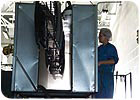
Unlike many custom coating operations, Miller also has an automotive-quality electrocoat system. Besides allowing Miller to provide e-coated parts, the system also gives the company the option of priming parts (before topcoat) that might be subjected to harsh outdoor environments.
Miller’s topcoat options are many. The company boasts a liquid paint system that can apply standard bake and two-component (2K) low bake paints. All parts are electrostatically coated. Plastic parts typically have a conductive primer applied and then are electrostatically topcoated, thereby ensuring efficiency, cost-effectiveness and consistent coverage.
One of the most remarkable features of the company’s liquid paint lines is the ability to prime and bake, then topcoat and bake without having to handle the parts. This operation is possible because each liquid coating booth has an in-line dedicated oven. Less sophisticated systems might need to prime, bake, then remove and re-hang parts to accomplish the same result.
In addition to its e-coating and liquid paint capability, Miller can apply powder coating. As a matter of fact, approximately 80% of all the electrocoated parts destined for topcoat are powder coated. The powder coat line includes automatic electrostatic spray guns augmented with manual electrostatic touch-up.
The important aspect of all this finishing versatility is the limitless options available for the customer. Multiple substrates, as well as differing finish requirements (e.g., exterior vs. interior service), can be tackled using the same coater. A good example of meeting a customer’s varied requirements is a recent project involving a pedestal system for laundry appliances. The pedestal is composed of a steel structure and a plastic drawer. The coating of choice for the structure was powder, whereas the acrylonitrile butadiene styrene (ABS) drawer called for a 2K urethane-based paint. Miller was able not only to bring the two different coating suppliers together to color match and develop the coatings, but it was also able to quickly implement the divergent coating schemes into its finishing operations. The project was behind schedule when the customer approached Miller, and Miller was able to turn it around in a matter of days. Prototypes were produced and approved, and soon thereafter Miller went into full production.
“Many times customers don’t realize the alternatives that are possible to meet their ultimate requirements,” says Stevens.
Integral to the success of Miller’s operations are the company’s continuous improvement teams (CITs). Initiated within the company, these groups now include Miller’s paint, chemical and equipment suppliers. Young says, “We’re not afraid to bring in our suppliers for these brainstorming sessions and to be part of that team. We have no pride of ownership or ego trip on solving a problem; we bring in everyone.”
Stevens says that the company has gone out of its way to include its suppliers in brainstorming and problem-solving. He describes a typical improvement meeting as, “We throw everything at the wall and then see what sticks.”
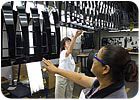
Mike Stevens sums it up saying, “Stay in business at what you’re good at doing.”
For Miller Products, these strengths include delivering the exact quality its customers need - whether their demands are for e-coat, powder, liquid paint, or any combination thereof.
For more information about Miller Products, call 616.454.8341 or visit www.miller-products.com.

One aspect of automotive culture deeply ingrained in Miller’s culture is the notion of maintaining high quality and delivering orders on time, every time.
Custom coaters used to be able to focus on one area of expertise - be it powder, electrocoat, wet spray or another technology - to create a successful niche for themselves. Increasingly, however, many finish coaters are finding that they must take on a broad array of services to remain competitive. Miller Products of Grand Rapids, MI, is one such company that has established itself as an industry leader by offering a full complement of electrocoat, powder and wet spray. Jeff Young, the director of quality and administration, sums it up well, “We offer a one-stop, single-source finishing facility.”

Miller’s ability to meet the increasingly rigorous criteria for Class “A” parts has helped the company grow into new markets.
An Automotive Culture
Through the years, Miller has served the automotive industry with Class “A” finishes. While the company originally applied only wet spray materials, it has added powder and electrocoat capabilities over the last few years to meet customers’ needs.Young says that the employees have been trained in Class “A” inspection, and that the criteria for Class “A” parts have become increasingly rigorous. “A part that 10 years ago would have been considered a Class ‘B’ finish must now be treated as a Class ‘A’ finish. This has helped us grow into new markets because of the evolving market need to provide higher quality,” he says. Such growth is no stretch for an operation accustomed to providing Class “A” products.
The automotive influence has extended into Miller’s process control. Years ago, achieving an ISO 9000 or TS 16949 quality rating was all that was needed to satisfy an automotive customer. While these standards require an operation to keep a process in control - that is, be able to demonstrate repeatability of manufacturing activities - they really don’t emphasize directly meeting a customer’s specification. The “Green Rating” instituted by General Motors extends beyond ISO and TS protocols and requires a supplier to demonstrate the capability to meet GM’s specifications continually. Certification to the Green Rating involves confirming that the coater’s processes have the capacity to deliver the specified quality. The operation is audited regularly to ensure that this capability is maintained. Miller Products has been certified to GM’s Green Rating since 1996, and it recently achieved a Ford Green Rating as well.
The other aspect of automotive culture deeply ingrained in Miller’s culture is the notion of maintaining high quality and delivering orders on time, every time. “Gone are the days when customers relied solely on price to determine where they would get their coating done,” says Mike Stevens, the company’s president. “The price must be competitive, but the most important issue is delivering the highest quality in a timely fashion. We have found through the years that this is the true formula for customer satisfaction.”

Approximately 80% of all the electrocoated parts destined for topcoat are powder coated.
Process Versatility
One of the most interesting aspects of Miller’s operation is the multitude of coating processes represented under one roof. The company has a rigorously maintained pretreatment system that can be adjusted to clean and pretreat the variety of substrates that regularly pass through their systems. The operating parameters are fine-tuned depending on whether the parts to be coated are steel, galvanized steel, aluminum or plastic. Miller’s supplier of the pretreatment chemicals has a technician inspect and adjust the process parameters several times per week.Unlike many custom coating operations, Miller also has an automotive-quality electrocoat system. Besides allowing Miller to provide e-coated parts, the system also gives the company the option of priming parts (before topcoat) that might be subjected to harsh outdoor environments.
Miller’s topcoat options are many. The company boasts a liquid paint system that can apply standard bake and two-component (2K) low bake paints. All parts are electrostatically coated. Plastic parts typically have a conductive primer applied and then are electrostatically topcoated, thereby ensuring efficiency, cost-effectiveness and consistent coverage.
One of the most remarkable features of the company’s liquid paint lines is the ability to prime and bake, then topcoat and bake without having to handle the parts. This operation is possible because each liquid coating booth has an in-line dedicated oven. Less sophisticated systems might need to prime, bake, then remove and re-hang parts to accomplish the same result.
In addition to its e-coating and liquid paint capability, Miller can apply powder coating. As a matter of fact, approximately 80% of all the electrocoated parts destined for topcoat are powder coated. The powder coat line includes automatic electrostatic spray guns augmented with manual electrostatic touch-up.
The important aspect of all this finishing versatility is the limitless options available for the customer. Multiple substrates, as well as differing finish requirements (e.g., exterior vs. interior service), can be tackled using the same coater. A good example of meeting a customer’s varied requirements is a recent project involving a pedestal system for laundry appliances. The pedestal is composed of a steel structure and a plastic drawer. The coating of choice for the structure was powder, whereas the acrylonitrile butadiene styrene (ABS) drawer called for a 2K urethane-based paint. Miller was able not only to bring the two different coating suppliers together to color match and develop the coatings, but it was also able to quickly implement the divergent coating schemes into its finishing operations. The project was behind schedule when the customer approached Miller, and Miller was able to turn it around in a matter of days. Prototypes were produced and approved, and soon thereafter Miller went into full production.
Continuous Improvement: Working with Customers and Suppliers
Miller Products realizes that its success is predicated on its customers’ success. Accordingly, the customer is pulled into the decision making process at the onset of a project. The requirements are reviewed, and coating scenarios are proposed.“Many times customers don’t realize the alternatives that are possible to meet their ultimate requirements,” says Stevens.
Integral to the success of Miller’s operations are the company’s continuous improvement teams (CITs). Initiated within the company, these groups now include Miller’s paint, chemical and equipment suppliers. Young says, “We’re not afraid to bring in our suppliers for these brainstorming sessions and to be part of that team. We have no pride of ownership or ego trip on solving a problem; we bring in everyone.”
Stevens says that the company has gone out of its way to include its suppliers in brainstorming and problem-solving. He describes a typical improvement meeting as, “We throw everything at the wall and then see what sticks.”

All Miller Products employees have been trained in Class “A” inspection.
A Motivated Workforce
Miller Products employs nearly 90 people at its Grand Rapids facilities. The Teamsters union represents the labor force, and Stevens remarks that they enjoy a good relationship. A strong work ethic is pervasive throughout the plant, and longevity of employment is the rule and not the exception. Miller’s management team strives to keep the workers informed of the company’s progress. Productivity and business data is shared openly with the diverse base of employees. Consequently, Miller enjoys a low turnover rate. “Our painters are mostly lifelong employees, and their expertise is due to their more than 100 years of combined experience,” Stevens says.The Future
Miller Products has a long history of adapting to the changing winds common in the industrial finishing arena. The automotive industry ebbs and flows with market influences, foreign threats and the national economy. It is Miller’s goal to expand by diversifying into other quality-conscious, markets especially those demanding Class “A” appearance and performance.Mike Stevens sums it up saying, “Stay in business at what you’re good at doing.”
For Miller Products, these strengths include delivering the exact quality its customers need - whether their demands are for e-coat, powder, liquid paint, or any combination thereof.
For more information about Miller Products, call 616.454.8341 or visit www.miller-products.com.
Looking for a reprint of this article?
From high-res PDFs to custom plaques, order your copy today!






